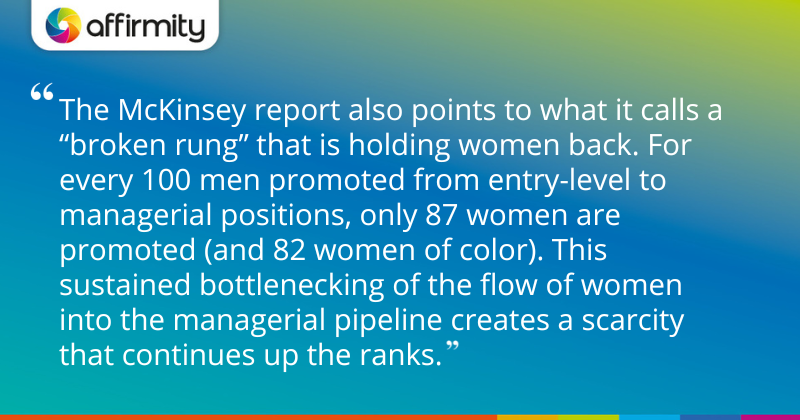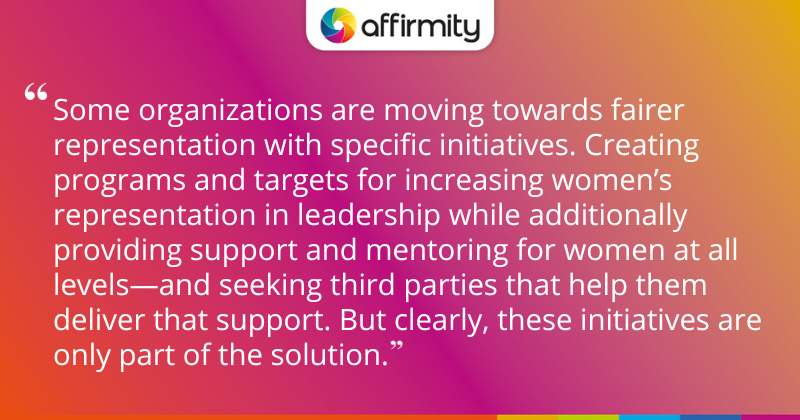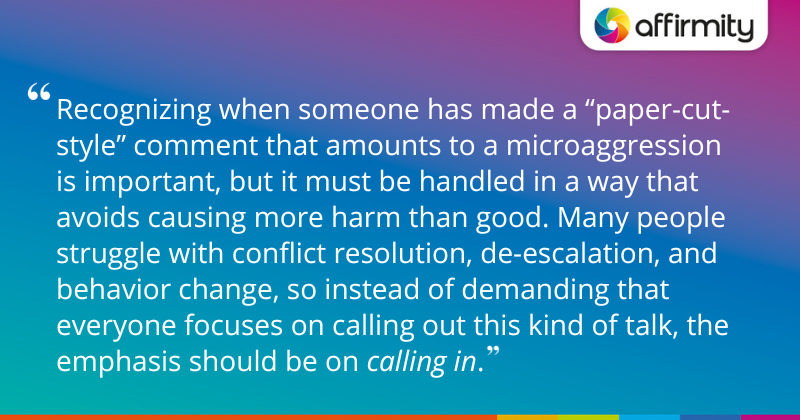Creating a working world where women receive the same access to professional opportunities as their male peers has long persisted as a goal of diversity, equity, and inclusion work. But as Suzanne Zudiker, a global inclusion account director at GP Strategies (an Affirmity inclusion training partner), observes, this area of inequality stubbornly persists regardless of professional ability. Read on to discover why meritocracy is a myth, and how organizations can start to compensate for the setbacks that many women experience on their way to the top.
A recent report by the IBM Institute for Business Value opened with the nugget that going into 2023, the number of women in organizational C-suites and sitting on executive boards had increased by 12%. This recognition of progress struck an optimistic tone that the report writers inevitably dropped in short order—lower down the ladder, they saw cause for concern. The percentage of women going from junior professional to senior professional level is actually shrinking. Furthermore, after that 12% YoY growth, women still only accounted for one in four C-suite positions on average, with only one in every 20 C-suite members being a woman of color.
Even the staunchest believers in meritocracy must acknowledge that for these numbers to be a fair reflection of who merit alone raises to positions of power, everyone must have a similar starting point. In reality, women at all levels must reckon with microaggressions and biases which specifically downplay and undermine their merit. According to McKinsey’s Women in the Workplace 2022 report, women leaders are:
- Twice as likely to be mistaken for a person in a more junior role (26% compared with 13% of male leaders)
- Twice as likely to have someone say or imply they’re not qualified for their position (12% versus 6%)
- More likely to experience a co-worker getting credit for their idea (27% versus 21%)
These behaviors are really just the tip of the iceberg, and inevitably even more serious for specific groups when intersectional data is considered (for example, 20% of black women leaders have experienced someone saying or implying they’re not qualified for their role).
MORE FROM THE BLOG | ‘Getting the Business On Your Side: How to Talk About Affirmative Action Data With Everyone Else’

Why Are We Still in This Situation?
Why is gender parity in leadership “at least three decades away?” as the aforementioned IBM Institute report suggests? As ever, significant contributors are a lack of prioritization for diversity metrics and goals, coupled with a lack of managerial and human resources accountability in this area.
The McKinsey report also points to what it calls a “broken rung” that is holding women back. According to its findings, for every 100 men promoted from entry-level to managerial positions, only 87 women are promoted (and 82 women of color). This is a persistent problem—witnessed in eight consecutive reporting years—and this sustained bottlenecking of the flow of women into the managerial pipeline creates a scarcity that continues up the ranks.
Another, more recently emerging problem, is that women leaders are leaving companies at a greater rate. McKinsey states that for every woman at the director level who gets promoted to the next level, two women directors are choosing to leave their company. This can be attributed to the greater “headwinds” that women experience in leadership—they’re just as likely to want a promotion, but factors such as the entrenched microaggressions and biases previously highlighted make a move outside of the business more desirable.
STATS ON CURRENT DE&I PRACTICES | ‘5 Important Questions Answered in the 2023 Future of Diversity, Equity, Inclusion, and Belonging Report’

What Can Be Done to Improve Women’s Representation in Leadership?
There are, of course, some organizations that are moving towards fairer representation. Many have specific initiatives, creating programs and targets for increasing women’s representation in leadership while additionally providing support and mentoring for women at all levels—and seeking third parties that help them deliver that support. But clearly, these initiatives are only part of the solution if gender parity is to be achieved any time soon.
A wide array of actions big and small are required from allies and organizations to move the needle. Here are just a few to incorporate into your current practices:
1) Train the Right People
Everyone in a position responsible for hiring or people management requires appropriate training, starting with education on unconscious bias (which should ideally cover the whole team). You also need to provide tools and tips on how to be an inclusive manager, with a focus on treating teams equitably rather than just equally.
Managers must also be trained on how to guide their teams through their careers, especially when they may not automatically connect or personally understand the needs of their reports. These processes need to be supported by clear HR structures and a system of checks and balances—biases occur no matter how well you train people, and the structures you build will help you mitigate their effects.

2) Don’t Just “Call Out”, “Call In”
You should continue to encourage your people to make changes to the language they use. Women are regularly described as too strong and abrasive in scenarios where men would be considered smart and great to work with (and at worst, slightly impatient). One recent study published in the Society for Personality and Social Psychology reveals a clear indication of gender positivity in a workplace setting, finding that “Across studies, people prioritized the goal of kindness more when they gave, or anticipated giving, critical feedback to a woman versus a man.”
Recognizing when someone has made a “paper-cut-style” comment that amounts to a microaggression is important, but it’s important to handle it in a way that avoids causing more harm than good. Many people struggle with conflict resolution, de-escalation, and behavior change, so instead of demanding that everyone focuses on calling out this kind of talk, the emphasis should be on “calling in”. This involves understanding the root of what is said and teaching everyone how to address and ultimately prevent these usually unintentional slights.
3) Require Managers to Justify Their Selections
Managers need to be able to justify why they’ve selected people for specific roles and tasks. It’s their responsibility to understand the individual workloads of their team, and to make judgments on the skills required, the time it should take to deliver, and how the task may be leveraged in the development of their employees. Therefore, if they were asked to provide these justifications via a framework submission, it should be quite simple for them to manage.
Process-driven work allocation methods such as this will help eliminate common, frequently gendered biases around competency and capability. You should be able to create a culture where managers can’t lazily conclude “he seemed like the best guy to get the job done” or “she seems a little overloaded today, she should be allowed to focus on catching up” if those judgments cannot be justified.
FURTHER THOUGHTS ON CAREER MOBILITY | ‘5 Self-Critical Questions That Help Organizations Support the Career Mobility of Marginalized Groups’
In Conclusion
Though the principles of a meritocracy provide a useful guiding ideal, the reality is that talented people can and will be undermined by biases and inequitable treatment and situations. The balance must be redressed, and though there’s much work still to be done before we achieve true gender and diversity parity in senior positions, organizations are taking steps in the right direction.
If you would like to discuss how to create a more diverse, inclusive, and equitable organization, please contact us today.
A version of this article originally appeared on Consulting.us.
 About the Author
About the Author
Suzanne Zudiker is a global inclusion account director at GP Strategies with over 15 years of experience in diversity, equity, and inclusion (DE&I), management consulting, and organizational culture change work across a wide variety of different sectors. She brings both an external corporate social responsibility and internal employee engagement lens to a range of organizational DE&I cultural challenges.
